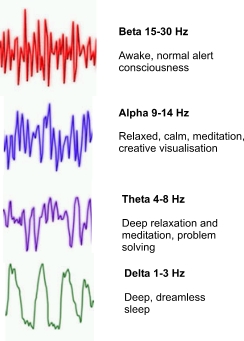In order to understand how Hypnosis works, one must first gain an understanding of thoughts,
and their importance in how they influence our decisions on a day to day basis.
There are 4 types of brain waves, listed below. (Beta, Alpha, Theta, and Delta):
Every thought is electric.
We can measure the electrical activity that goes on in the brain using an EEG machine, in cycles per second.
Next to each of the brain waves listed above, is a number in Hz. This is representative of cycles per second; or, in other words, how frequent our thoughts are occurring; how frequent our neurons are firing per second.
The subconscious mind (which is present during hypnosis) is activated in the Alpha, Theta, and Delta states, where thoughts are less frequent.
On the other hand, our conscious mind is in Beta.
This is where our thoughts are going fast-paced, usually when we're stressed or agitated, or even taking a test, where we need to be concentrated on something that requires a lot of our attention. This is where we typically function throughout the day. It is in Beta brainwave function where we experience EGO. Our egos resist changes in our behavior. This is why the key to hypnosis, is to relax brainwave function to a slower state, in order to bypass the resistance of one's ego during Beta brainwave function.
The moment we enter an Alpha state, where our thoughts are slightly less frequent, this is a light hypnotic state. Our subconscious is present, yet our conscious mind is still somewhat active here, as we are still aware of what's going on around us. However, in an alpha state, we are able to bypass the ego. Many of us slip in and out of this state multiple times a day quite naturally, such as when we dream, daydream, watch TV, read, or even drive a familiar route. On average, we spend about 4 hours per day in the alpha brainwave state. 95% of people can achieve this state, at will, during a hypnosis session.
Once our mind enters into a Theta state, at 4-7 cycles per second, images begin to form, and it is as though our conscious mind is taking a complete rest, and allowing the subconscious to take over. This is a state of complete and total relaxation. On average, 70% of hypnosis subjects achieve the Theta state. It is in this state where one experiences amnesia, and may have faded memories of the hypnosis session.
Finally, the Delta brainwave state corresponds to our deep sleep state, also known as REM (rapid eye movement) sleep. We spend an average of 3 hours per night in this state. Delta functions between .05-3.5 cycles per second, and in this state, we are completely unconscious, and don't have any memories of what has happened in and around us during this time. Only about 5% of hypnosis subjects will slip into this somnambulist state during a hypnosis session.
Here is an interesting video about how to achieve your goals with intention by entering the most ideal brainwave state to set and achieve them:

No comments:
Post a Comment